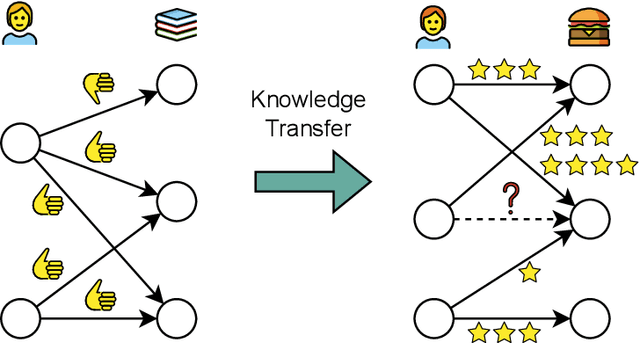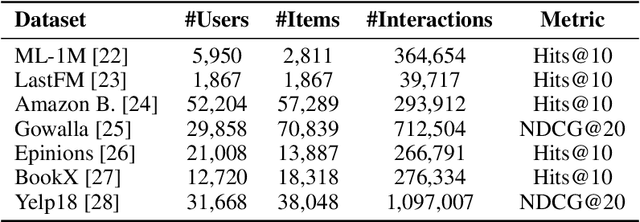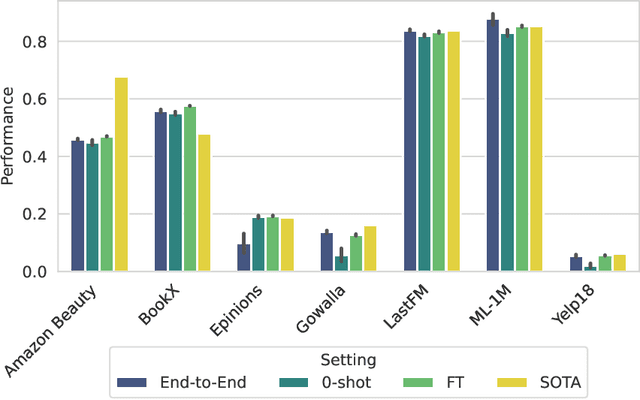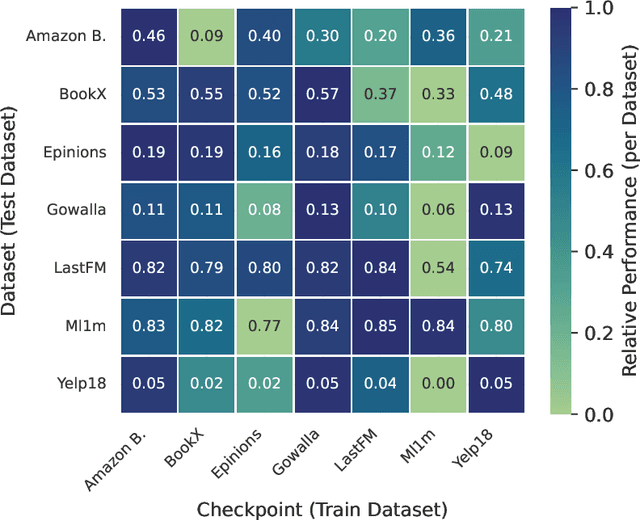Recommendation
Recommendation is the task of providing personalized suggestions to users based on their preferences and behavior.
Papers and Code
GTR-Mamba: Geometry-to-Tangent Routing for Hyperbolic POI Recommendation
Oct 27, 2025Next Point-of-Interest (POI) recommendation is a critical task in modern Location-Based Social Networks (LBSNs), aiming to model the complex decision-making process of human mobility to provide personalized recommendations for a user's next check-in location. Existing POI recommendation models, predominantly based on Graph Neural Networks and sequential models, have been extensively studied. However, these models face a fundamental limitation: they struggle to simultaneously capture the inherent hierarchical structure of spatial choices and the dynamics and irregular shifts of user-specific temporal contexts. To overcome this limitation, we propose GTR-Mamba, a novel framework for cross-manifold conditioning and routing. GTR-Mamba leverages the distinct advantages of different mathematical spaces for different tasks: it models the static, tree-like preference hierarchies in hyperbolic geometry, while routing the dynamic sequence updates to a novel Mamba layer in the computationally stable and efficient Euclidean tangent space. This process is coordinated by a cross-manifold channel that fuses spatio-temporal information to explicitly steer the State Space Model (SSM), enabling flexible adaptation to contextual changes. Extensive experiments on three real-world datasets demonstrate that GTR-Mamba consistently outperforms state-of-the-art baseline models in next POI recommendation.
MGFRec: Towards Reinforced Reasoning Recommendation with Multiple Groundings and Feedback
Oct 27, 2025The powerful reasoning and generative capabilities of large language models (LLMs) have inspired researchers to apply them to reasoning-based recommendation tasks, which require in-depth reasoning about user interests and the generation of recommended items. However, previous reasoning-based recommendation methods have typically performed inference within the language space alone, without incorporating the actual item space. This has led to over-interpreting user interests and deviating from real items. Towards this research gap, we propose performing multiple rounds of grounding during inference to help the LLM better understand the actual item space, which could ensure that its reasoning remains aligned with real items. Furthermore, we introduce a user agent that provides feedback during each grounding step, enabling the LLM to better recognize and adapt to user interests. Comprehensive experiments conducted on three Amazon review datasets demonstrate the effectiveness of incorporating multiple groundings and feedback. These findings underscore the critical importance of reasoning within the actual item space, rather than being confined to the language space, for recommendation tasks.
Inductive Transfer Learning for Graph-Based Recommenders
Oct 26, 2025



Graph-based recommender systems are commonly trained in transductive settings, which limits their applicability to new users, items, or datasets. We propose NBF-Rec, a graph-based recommendation model that supports inductive transfer learning across datasets with disjoint user and item sets. Unlike conventional embedding-based methods that require retraining for each domain, NBF-Rec computes node embeddings dynamically at inference time. We evaluate the method on seven real-world datasets spanning movies, music, e-commerce, and location check-ins. NBF-Rec achieves competitive performance in zero-shot settings, where no target domain data is used for training, and demonstrates further improvements through lightweight fine-tuning. These results show that inductive transfer is feasible in graph-based recommendation and that interaction-level message passing supports generalization across datasets without requiring aligned users or items.
CLIN-LLM: A Safety-Constrained Hybrid Framework for Clinical Diagnosis and Treatment Generation
Oct 26, 2025Accurate symptom-to-disease classification and clinically grounded treatment recommendations remain challenging, particularly in heterogeneous patient settings with high diagnostic risk. Existing large language model (LLM)-based systems often lack medical grounding and fail to quantify uncertainty, resulting in unsafe outputs. We propose CLIN-LLM, a safety-constrained hybrid pipeline that integrates multimodal patient encoding, uncertainty-calibrated disease classification, and retrieval-augmented treatment generation. The framework fine-tunes BioBERT on 1,200 clinical cases from the Symptom2Disease dataset and incorporates Focal Loss with Monte Carlo Dropout to enable confidence-aware predictions from free-text symptoms and structured vitals. Low-certainty cases (18%) are automatically flagged for expert review, ensuring human oversight. For treatment generation, CLIN-LLM employs Biomedical Sentence-BERT to retrieve top-k relevant dialogues from the 260,000-sample MedDialog corpus. The retrieved evidence and patient context are fed into a fine-tuned FLAN-T5 model for personalized treatment generation, followed by post-processing with RxNorm for antibiotic stewardship and drug-drug interaction (DDI) screening. CLIN-LLM achieves 98% accuracy and F1 score, outperforming ClinicalBERT by 7.1% (p < 0.001), with 78% top-5 retrieval precision and a clinician-rated validity of 4.2 out of 5. Unsafe antibiotic suggestions are reduced by 67% compared to GPT-5. These results demonstrate CLIN-LLM's robustness, interpretability, and clinical safety alignment. The proposed system provides a deployable, human-in-the-loop decision support framework for resource-limited healthcare environments. Future work includes integrating imaging and lab data, multilingual extensions, and clinical trial validation.
A Closed-Loop Personalized Learning Agent Integrating Neural Cognitive Diagnosis, Bounded-Ability Adaptive Testing, and LLM-Driven Feedback
Oct 26, 2025As information technology advances, education is moving from one-size-fits-all instruction toward personalized learning. However, most methods handle modeling, item selection, and feedback in isolation rather than as a closed loop. This leads to coarse or opaque student models, assumption-bound adaptivity that ignores diagnostic posteriors, and generic, non-actionable feedback. To address these limitations, this paper presents an end-to-end personalized learning agent, EduLoop-Agent, which integrates a Neural Cognitive Diagnosis model (NCD), a Bounded-Ability Estimation Computerized Adaptive Testing strategy (BECAT), and large language models (LLMs). The NCD module provides fine-grained estimates of students' mastery at the knowledge-point level; BECAT dynamically selects subsequent items to maximize relevance and learning efficiency; and LLMs convert diagnostic signals into structured, actionable feedback. Together, these components form a closed-loop framework of ``Diagnosis--Recommendation--Feedback.'' Experiments on the ASSISTments dataset show that the NCD module achieves strong performance on response prediction while yielding interpretable mastery assessments. The adaptive recommendation strategy improves item relevance and personalization, and the LLM-based feedback offers targeted study guidance aligned with identified weaknesses. Overall, the results indicate that the proposed design is effective and practically deployable, providing a feasible pathway to generating individualized learning trajectories in intelligent education.
Civic Ground Truth in News Recommenders: A Method for Public Value Scoring
Oct 26, 2025Research in news recommendation systems (NRS) continues to explore the best ways to integrate normative goals such as editorial objectives and public service values into existing systems. Prior efforts have incorporated expert input or audience feedback to quantify these values, laying the groundwork for more civic-minded recommender systems. This paper contributes to that trajectory, introducing a method for embedding civic values into NRS through large-scale, structured audience evaluations. The proposed civic ground truth approach aims to generate value-based labels through a nationally representative survey that are generalisable across a wider news corpus, using automated metadata enrichment.
AesCrop: Aesthetic-driven Cropping Guided by Composition
Oct 26, 2025Aesthetic-driven image cropping is crucial for applications like view recommendation and thumbnail generation, where visual appeal significantly impacts user engagement. A key factor in visual appeal is composition--the deliberate arrangement of elements within an image. Some methods have successfully incorporated compositional knowledge through evaluation-based and regression-based paradigms. However, evaluation-based methods lack globality while regression-based methods lack diversity. Recently, hybrid approaches that integrate both paradigms have emerged, bridging the gap between these two to achieve better diversity and globality. Notably, existing hybrid methods do not incorporate photographic composition guidance, a key attribute that defines photographic aesthetics. In this work, we introduce AesCrop, a composition-aware hybrid image-cropping model that integrates a VMamba image encoder, augmented with a novel Mamba Composition Attention Bias (MCAB) and a transformer decoder to perform end-to-end rank-based image cropping, generating multiple crops along with the corresponding quality scores. By explicitly encoding compositional cues into the attention mechanism, MCAB directs AesCrop to focus on the most compositionally salient regions. Extensive experiments demonstrate that AesCrop outperforms current state-of-the-art methods, delivering superior quantitative metrics and qualitatively more pleasing crops.
Towards Explainable Personalized Recommendations by Learning from Users' Photos
Oct 24, 2025Explaining the output of a complex system, such as a Recommender System (RS), is becoming of utmost importance for both users and companies. In this paper we explore the idea that personalized explanations can be learned as recommendation themselves. There are plenty of online services where users can upload some photos, in addition to rating items. We assume that users take these photos to reinforce or justify their opinions about the items. For this reason we try to predict what photo a user would take of an item, because that image is the argument that can best convince her of the qualities of the item. In this sense, an RS can explain its results and, therefore, increase its reliability. Furthermore, once we have a model to predict attractive images for users, we can estimate their distribution. Thus, the companies acquire a vivid knowledge about the aspects that the clients highlight of their products. The paper includes a formal framework that estimates the authorship probability for a given pair (user, photo). To illustrate the proposal, we use data gathered from TripAdvisor containing the reviews (with photos) of restaurants in six cities of different sizes.
Generative Reasoning Recommendation via LLMs
Oct 23, 2025Despite their remarkable reasoning capabilities across diverse domains, large language models (LLMs) face fundamental challenges in natively functioning as generative reasoning recommendation models (GRRMs), where the intrinsic modeling gap between textual semantics and collaborative filtering signals, combined with the sparsity and stochasticity of user feedback, presents significant obstacles. This work explores how to build GRRMs by adapting pre-trained LLMs, which achieves a unified understanding-reasoning-prediction manner for recommendation tasks. We propose GREAM, an end-to-end framework that integrates three components: (i) Collaborative-Semantic Alignment, which fuses heterogeneous textual evidence to construct semantically consistent, discrete item indices and auxiliary alignment tasks that ground linguistic representations in interaction semantics; (ii) Reasoning Curriculum Activation, which builds a synthetic dataset with explicit Chain-of-Thought supervision and a curriculum that progresses through behavioral evidence extraction, latent preference modeling, intent inference, recommendation formulation, and denoised sequence rewriting; and (iii) Sparse-Regularized Group Policy Optimization (SRPO), which stabilizes post-training via Residual-Sensitive Verifiable Reward and Bonus-Calibrated Group Advantage Estimation, enabling end-to-end optimization under verifiable signals despite sparse successes. GREAM natively supports two complementary inference modes: Direct Sequence Recommendation for high-throughput, low-latency deployment, and Sequential Reasoning Recommendation that first emits an interpretable reasoning chain for causal transparency. Experiments on three datasets demonstrate consistent gains over strong baselines, providing a practical path toward verifiable-RL-driven LLM recommenders.
Rotate Both Ways: Time-and-Order RoPE for Generative Recommendation
Oct 23, 2025Generative recommenders, typically transformer-based autoregressive models, predict the next item or action from a user's interaction history. Their effectiveness depends on how the model represents where an interaction event occurs in the sequence (discrete index) and when it occurred in wall-clock time. Prevailing approaches inject time via learned embeddings or relative attention biases. In this paper, we argue that RoPE-based approaches, if designed properly, can be a stronger alternative for jointly modeling temporal and sequential information in user behavior sequences. While vanilla RoPE in LLMs considers only token order, generative recommendation requires incorporating both event time and token index. To address this, we propose Time-and-Order RoPE (TO-RoPE), a family of rotary position embedding designs that treat index and time as angle sources shaping the query-key geometry directly. We present three instantiations: early fusion, split-by-dim, and split-by-head. Extensive experiments on both publicly available datasets and a proprietary industrial dataset show that TO-RoPE variants consistently improve accuracy over existing methods for encoding time and index. These results position rotary embeddings as a simple, principled, and deployment-friendly foundation for generative recommendation.
 Add to Chrome
Add to Chrome Add to Firefox
Add to Firefox Add to Edge
Add to Edge